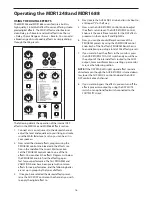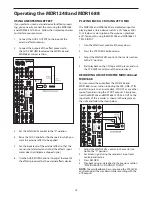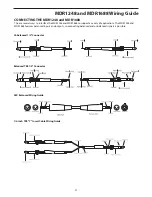
8
MONO INPUT CHANNEL SECTION - continued
Auxiliary Busses ( 4 - 6 )
The MDR series include two auxiliary signal paths, or
buses, that can be used to create independent mixes for
sending to the internal or external effects processors, or
to an external monitor system. The flow of these buses
start by sending the signal from each individual channel,
which is set with one of the auxiliary control knobs. Then,
the mix of all the channels auxiliary level is ultimately sent
to either an internal effects processors, or to an output
jack to connect to an external effect or monitor system. To
help you control your effects and monitor mixes, the MDR
mixers have two auxiliary buses. Plus, for added flexabil-
ity, AUX1 can be configured as a Pre or Post fader send.
PRE….? POST….? What’s That?
In order to operate your mixer correctly, it is important
to understand the concept of PRE and POST Fader Aux
sends. An auxiliary bus that is set up as PRE Fader routes,
or sends, the signal to its output from a point in the chan-
nels’ circuit that is electronically before the channel Fader.
That means the channel Fader has no effect on the PRE
aux level. A Pre Fader send is what you want to use for a
monitor mix, so when the level is changed for the mix in
the main PA speakers using the channel Fader, the level
in the monitor set by the aux control knob remains the
same. An auxiliary bus that is set up as POST Fader routes,
or sends, the signal to its output from a point in the chan-
nels’ circuit that is electronically after the channel Fader.
That means that the channel Fader also affects the level of
a POST aux send. A POST Aux bus is what you want to use
(almost always) for sending to an effects processor, either
internal or external. When using the POST aux sends,
(while turning the channel Fader up or down) the level of
effects will track the channel level correctly.
4 - AUX 1
The MDR1248 and MDR1688 have two auxiliary sends
which can be used for sending signals to external effects
devices or for creating a monitor mix. The AUX1 section
is often used for a monitor mix in a live sound mixing, or
for a headphone mix in a recording application. AUX 1
can also be used as a Pre Fader effect send by setting the
Pre/Post switch to the Post postion. Each input channel
includes an AUX 1 send which controls the amount of that
channel’s signal that is sent to the AUX bus.
NOTE:
If the AUX1Pre/Post switch is set to Pre, the Aux
controls are "PRE-FADER SENDS" which means they are
not affected by the FADER level settings of each channel.
This allows you to create a mix for the monitors that is
independent of the main LEFT and RIGHT MIX.
5 - PRE/POST - switch
The PRE/POST switch is used to select the point that the
AUX 1 bus uses to send the signal. When the PRE/POST
switch is set to PRE, the signal feeding AUX 1 is sent
before the fader, so the channel Fader has no effect on
that level. This is the normal setting when using AUX 1 as
Controls and Functions
a monitor send. When the PRE/POST switch is set to POST,
the signal feeding AUX 1 is sent after the fader, so the
channel Fader has an effect on that level, meaning the
Aux level tracks up and down with the channel Fader. This
is the normal setting for using AUX 1 as an effects send,
since when you set the channel louder, you normally
want the effect to get louder.
NOTE: The channel’s effects signal is sent to the AUX 1
bus from a location in the signal path after the VOLUME
control.
6 - AUX 2/DSP
The channel’s AUX 2/DSP knob controls the amount of
signal that is sent to the AUX 2 bus. The AUX 2 signal can
be sent to an external effects device connected to the
AUX 2 OUT jack located in the MASTER SECTION jack field.
NOTE: The channel’s AUX 2 signal is sent to the AUX 2
bus from a location in the signal path after the channel’s
LEVEL control. This is commonly referred to as a POST
FADER send. This means that the amount of signal that is
sent to the AUX 2 bus will be affected not only by the set-
ting of the AUX 2 knob control, but it will also be affected
by the setting of the LEVEL control.
7 - PAN
The MDR1248 and MDR1688’s PAN control is used to
place or position the mono signal into the stereo main
Left and Right MIX bus. You can create a stereo image
by panning some input signals to the left and others to
the right. The MDR1248 and MDR1688’s PAN control is a
Power-Pan circuit, which includes a 3dB dip in the center
position. This is desirable since there’s a 3dB increase in
gain when the mono input signal is heard in both the Left
and Right MIX bus.
8 - 3/4 MUTE switch
The Mono Input channels feature a 3/4 MUTE switch
allowing you to easily turn that channel on or off. When
3/4 MUTE LED is illuminated, the channel is off, converse-
ly, when the backlight is off, the channel is on. The switch
also has a second purpose. When the switch is pressed
down, signal from the selected channels is sent to the
3/4 Outputs. This lets you use 3/4 as a second stereo bus
which can be mixed in with the main left and right mix
bus or sent out the 3/4 outputs without being heard in
the main Left and Right mix.
9 – 3/4 MUTE LED
The MDR1248 and MDR1688’s has a 3/4 Mute LED indica-
tor allowing you to easily see if the channel is muted or
assigned to the 3/4 mix bus. When 3/4 MUTE LED is illu-
minated, the channel is off and assigned to the 3/4 bus,
conversely, when the backlight is off, the channel is on
and not assigned to the 3/4 mix bus.
10 - Solo switch
The Mono Input channel’s Solo switch allows you to
listen, or “solo” a channel or group of channels in the
headphones. When the SOLO switch is pressed down, the
channel is assigned to the solo bus and can be heard












































